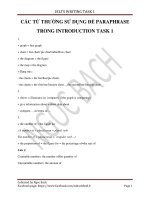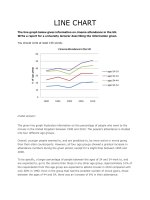Task 1 sgdjhcdsgjfgvbscjbgj
Bạn đang xem bản rút gọn của tài liệu. Xem và tải ngay bản đầy đủ của tài liệu tại đây (32.53 KB, 2 trang )
Task 1:
The two charts give information about the gender and number of athletes who have
entered the Games since they started. The bar chart illustrates the number of men and
women entering the Games, whereas the line graph shows the number of participants.
It is evident from the bar chart that, until 2012, there were always significantly more men
entering the Games than women. In 1924 and 1952, there were hardly any women
entering the Games, yet in 1952 there were over 4,000 male participants. In 2012,
however, the number of female athletes rose significantly to nearly 5,000, only
approximately 1,000 lower than male participants.
The line graph shows a similar trend, with the number of participants increasing
throughout the century. The most significant increase occurred between 1984 and 2012
when the number of athletes rose from just over 6,000 to over 10,000 in 2012.
To summarise, therefore, since 1924 the number of athletes entering the Olympic Games,
has increased dramatically. This is particularly the case for women, who are now
represented in nearly the same numbers as male participants.
Task 2:
The number of students studying has been increasing in recent years. It is often
considered that this trend has a positive impact on students and the countries involved.
First and foremost, studying abroad exposes students to different cultures and
backgrounds. Learning other’s cultures and backgrounds is vital and beneficial as it
deepens an individual’s knowledge base. Likewise, sometimes it helps students who
study abroad tend to perform better than those who study locally. Thus, it is safe to say
that studying abroad can help students to learn about new cultures and backgrounds.
However, having many overseas students in a country may increase the competitive
rate of getting accepted into local universities. This may have a vnegative impact on local
students as it might be harder to be accepted by local universities and would be
exceptionally tough to get into prestigious universities. As an illustration, it is believed
that 40% of candidates who are accepted into local universities are normally overseas
students, leaving only 60% of the native students. Therefore, local students may be at a
disadvantage if this trend continues.
In a nutshell, it seems to me that the advantages outweigh the drawbacks, and having
more overseas students have a positive impact on students and the countries involved as
overseas students can broaden their horizons and have access to various cultures which
may be of good use later in their life.









